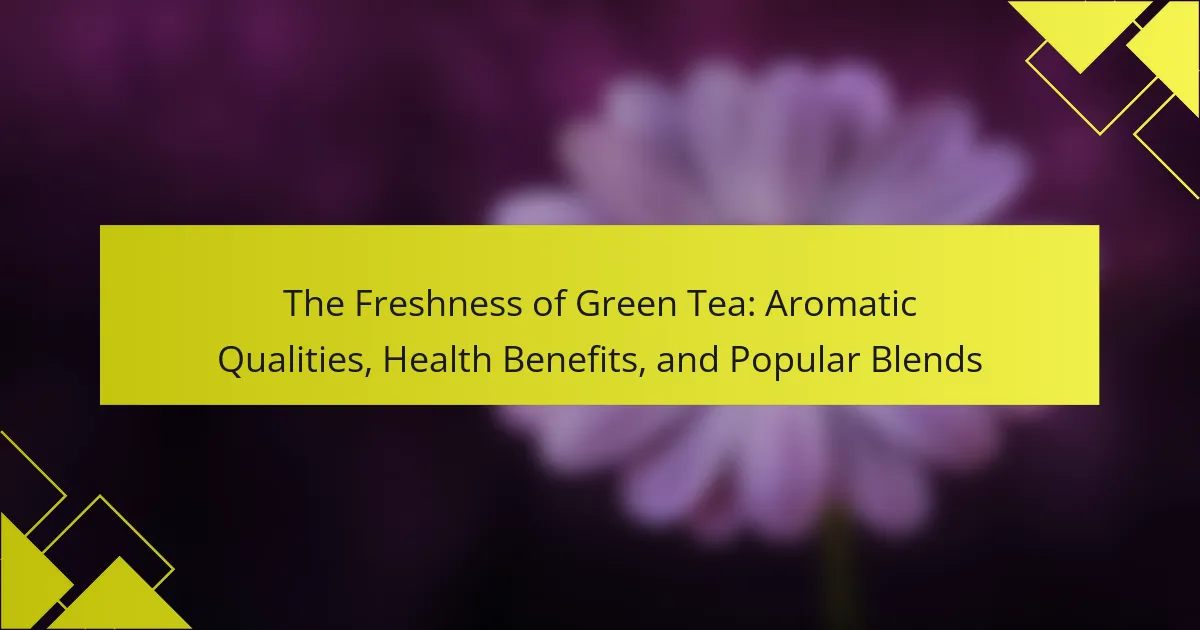
What are the fragrance notes of jasmine?
The fragrance notes of jasmine are primarily sweet, floral, and rich. Jasmine has a complex aroma profile that includes hints of fruitiness and a warm, sensual undertone. The top notes are often described as fresh and uplifting. The heart notes emphasize the deep floral characteristics. Jasmine is commonly used in perfumery due to its appealing scent. Its fragrance is known to evoke feelings of relaxation and romance. These qualities make jasmine a popular choice in various fragrance compositions.
How do jasmine fragrance notes contribute to its aroma profile?
Jasmine fragrance notes significantly enhance its aroma profile by providing a rich, sweet, and floral scent. These notes are characterized by their warm, sensual qualities. Jasmine’s aroma is often described as intoxicating and uplifting. It contains compounds such as benzyl acetate and indole, which contribute to its unique scent. The sweet and exotic nature of jasmine makes it a popular choice in perfumery. Additionally, jasmine notes can evoke feelings of relaxation and euphoria. This emotional response is supported by studies showing jasmine’s calming effects on the mind. Overall, jasmine fragrance notes create a complex and appealing aroma profile that is widely appreciated.
What are the primary aroma characteristics of jasmine?
Jasmine has a rich, sweet, and floral aroma. This fragrance is often described as romantic and exotic. The scent profile includes warm, creamy undertones. Jasmine is also noted for its slightly fruity notes. It is commonly used in perfumes and aromatherapy. The aroma can evoke feelings of relaxation and euphoria. Jasmine’s scent is derived from its essential oil, which contains various aromatic compounds. These compounds contribute to its complex and appealing fragrance.
How do top, middle, and base notes in jasmine interact?
Top, middle, and base notes in jasmine interact to create a layered fragrance experience. Top notes provide an initial burst of freshness and brightness. They are typically light and evaporate quickly. Middle notes emerge after the top notes dissipate. These notes form the heart of the fragrance, offering a richer and more complex aroma. Base notes provide depth and longevity to the scent. They are heavier and linger the longest on the skin. Together, these notes harmonize to create a balanced and evolving fragrance profile. This interaction enhances the overall olfactory experience of jasmine, making it a popular choice in perfumery.
What are the different types of jasmine used in fragrances?
The different types of jasmine used in fragrances include Jasmine Grandiflorum, Jasmine Sambac, and Jasmine Officinalis. Jasmine Grandiflorum is known for its rich, sweet aroma and is often used in high-end perfumes. Jasmine Sambac, native to Southeast Asia, has a more intense and fruity scent, making it popular in both perfumes and essential oils. Jasmine Officinalis, also known as Common Jasmine, offers a lighter and more delicate fragrance, suitable for various applications. These jasmine types contribute unique olfactory profiles that enhance the overall scent experience in perfumery.
What are the unique attributes of each jasmine variety?
Jasmine varieties have unique attributes that distinguish them from one another. Jasminum grandiflorum is known for its strong, sweet fragrance and is often used in perfumes. Jasminum sambac has a more delicate aroma and is commonly used in traditional teas. Jasminum nudiflorum blooms in winter and has a lighter scent, making it unique among jasmine types. Jasminum polyanthum is recognized for its prolific flowering and robust scent. Each variety’s distinct characteristics contribute to its specific uses in fragrance and culinary applications.
How do different jasmine types affect fragrance formulations?
Different jasmine types significantly influence fragrance formulations. Each type possesses unique aromatic profiles and chemical compositions. For example, Jasminum grandiflorum offers a rich, sweet scent, often used in perfumes. Jasminum sambac, on the other hand, provides a more delicate, fruity aroma. The specific compounds in each jasmine type, such as indole and benzyl acetate, contribute to their distinct fragrances. Additionally, the extraction methods can alter the intensity and character of the scent. Fragrance formulators select jasmine types based on desired scent profiles and target markets. This selection process impacts the overall quality and appeal of the final fragrance product.
What benefits does jasmine fragrance provide?
Jasmine fragrance provides various benefits, including mood enhancement and relaxation. The scent of jasmine has been shown to reduce anxiety and improve overall emotional well-being. Studies indicate that jasmine can promote better sleep quality due to its calming effects. Additionally, jasmine fragrance is known for its aphrodisiac properties, which may enhance romantic feelings. Its uplifting aroma can also boost confidence and increase alertness. Research has demonstrated that inhaling jasmine scent can lead to significant reductions in stress levels. This makes jasmine fragrance a popular choice in aromatherapy and personal care products.
How does jasmine aroma influence mood and emotions?
Jasmine aroma positively influences mood and emotions by reducing stress and promoting relaxation. Studies show that jasmine scent can lower anxiety levels. Research published in the Journal of Ethnopharmacology indicates that inhaling jasmine essential oil can enhance feelings of well-being. Participants reported improved mood and decreased tension after exposure to jasmine aroma. The scent activates the brain’s limbic system, which is responsible for emotional responses. Jasmine’s calming properties make it a popular choice in aromatherapy. Overall, jasmine aroma serves as a natural mood enhancer.
What therapeutic properties are associated with jasmine fragrance?
Jasmine fragrance is associated with several therapeutic properties. It is known for its calming effects, which can help reduce anxiety and promote relaxation. Studies indicate that jasmine scent can enhance mood and alleviate depressive symptoms. Research published in the Journal of Biological Chemistry found that jasmine essential oil can lower heart rate and blood pressure, contributing to a sense of tranquility. Additionally, jasmine fragrance is believed to improve sleep quality by promoting deeper and more restful sleep. Its uplifting aroma can also stimulate feelings of happiness and well-being.

How can jasmine fragrance be used effectively?
Jasmine fragrance can be used effectively in various ways. It can enhance mood and promote relaxation when diffused in the air. Aromatherapy studies show that jasmine scent can reduce anxiety and improve sleep quality. Additionally, jasmine can be blended with carrier oils for massage, providing both aromatic and therapeutic benefits. It is also popular in perfumes, where its sweet and floral notes create an inviting atmosphere. When used in candles or incense, jasmine can elevate the ambiance of a space. Furthermore, jasmine tea offers a fragrant beverage option that combines flavor with health benefits. These applications highlight the versatility of jasmine fragrance in enhancing well-being and sensory experiences.
What are the best methods for incorporating jasmine fragrance into daily life?
The best methods for incorporating jasmine fragrance into daily life include using jasmine essential oil, scented candles, and jasmine-infused products. Jasmine essential oil can be diffused in a room for a calming atmosphere. Scented candles with jasmine notes provide a pleasant aroma during relaxation or gatherings. Jasmine-infused lotions or body oils can enhance personal fragrance throughout the day. Additionally, jasmine tea offers a subtle fragrance and flavor experience. These methods allow for a consistent presence of jasmine fragrance in various daily activities.
How can jasmine be used in aromatherapy practices?
Jasmine can be used in aromatherapy practices through essential oil diffusion, topical application, and massage. Diffusing jasmine essential oil in a room creates a calming atmosphere. This practice may reduce anxiety and improve mood. Topical application involves diluting jasmine oil with a carrier oil. This method can soothe the skin and enhance relaxation. Jasmine oil is also commonly used in massage oils. It promotes emotional balance and alleviates stress. Studies have shown that jasmine aroma can lower cortisol levels, indicating reduced stress.
What are some creative ways to use jasmine in home fragrance?
Jasmine can be creatively used in home fragrance through various methods. One way is by using jasmine essential oil in a diffuser. This method disperses the scent throughout the room. Another option is to create jasmine-infused candles. These candles can provide a warm and inviting aroma. Additionally, jasmine can be added to potpourri for a natural fragrance boost. This combination of dried flowers and essential oils enhances the scent profile. Using jasmine in homemade sachets is also effective. These sachets can be placed in drawers or closets to keep them smelling fresh. Lastly, incorporating jasmine in homemade room sprays offers a quick scent refresh. This can be achieved by mixing jasmine oil with water in a spray bottle. Each method effectively utilizes jasmine’s sweet and floral aroma to enhance the home environment.
What tips should be followed when using jasmine fragrance?
When using jasmine fragrance, apply it to pulse points for optimal scent diffusion. Pulse points include the wrists, neck, and behind the ears. This enhances the fragrance’s projection and longevity. Avoid rubbing the fragrance after application, as this can alter its scent profile. Instead, let it dry naturally on the skin. For a more subtle effect, consider layering jasmine with unscented lotion. This can help soften the intensity while still enjoying the aroma. Additionally, store jasmine fragrance in a cool, dark place to maintain its quality. Exposure to light and heat can degrade the fragrance over time.
How can one select the right jasmine product for personal use?
To select the right jasmine product for personal use, consider the product’s formulation and scent profile. Look for jasmine essential oil, which offers pure aroma and therapeutic benefits. Check for quality indicators like organic certification and extraction methods. Choose products that list jasmine as a primary ingredient for authenticity. Assess your personal fragrance preferences, whether floral, sweet, or fresh. Review customer feedback for insights on efficacy and satisfaction. Ensure the product aligns with your intended use, such as for aromatherapy or skincare. Lastly, verify that the product is free from synthetic additives to maintain purity.
What precautions should be taken when using jasmine essential oil?
When using jasmine essential oil, it is important to take several precautions. Always perform a patch test before full application to check for allergic reactions. Dilute jasmine oil with a carrier oil to reduce the risk of skin irritation. Pregnant women should avoid using jasmine oil, as it may stimulate uterine contractions. Individuals with sensitive skin or allergies should consult a healthcare professional before use. Avoid direct sunlight after applying jasmine oil to the skin, as it can increase sensitivity. Keep jasmine essential oil away from children and pets to prevent accidental ingestion. Store the oil in a cool, dark place to maintain its potency.

What are the trends in jasmine fragrance usage?
Jasmine fragrance usage is increasingly popular in various products. The trend is particularly strong in perfumes and personal care items. Jasmine is valued for its sweet and floral aroma. It is often used in aromatherapy for relaxation. Recent studies show a rise in demand for natural and organic jasmine products. Consumers prefer jasmine blends that offer calming effects. Additionally, jasmine is being incorporated into home fragrances and candles. This trend reflects a broader interest in wellness and self-care.
How has the popularity of jasmine fragrance evolved over time?
The popularity of jasmine fragrance has evolved significantly over centuries. Initially, jasmine was highly valued in ancient cultures, such as in Egypt and India, for its aromatic properties. In the 18th century, jasmine became a staple in perfumery, particularly in France, where it was used in luxury fragrances. The rise of jasmine in Western perfumery coincided with the Romantic era, which emphasized floral scents. By the 20th century, jasmine was a key ingredient in many iconic perfumes, solidifying its status. Recent trends show a resurgence in natural and organic fragrances, leading to increased interest in jasmine’s therapeutic benefits. Today, jasmine continues to be popular in both personal fragrances and aromatherapy products.
What current trends are shaping the jasmine fragrance market?
Current trends shaping the jasmine fragrance market include a growing demand for natural and organic ingredients. Consumers increasingly prefer products that are sustainably sourced. The rise of clean beauty has led brands to reformulate with fewer synthetic chemicals. Additionally, the popularity of aromatherapy has boosted jasmine’s appeal for its calming properties. Personalization in fragrances is also trending, with consumers seeking unique jasmine blends. The market is witnessing an increase in jasmine-infused home fragrances due to the wellness trend. E-commerce growth facilitates wider access to jasmine products. Finally, social media influences fragrance trends, driving interest in jasmine-based scents.
How do consumer preferences influence jasmine fragrance development?
Consumer preferences significantly influence jasmine fragrance development. Manufacturers analyze market trends and consumer feedback to create appealing scents. Popular scent profiles often drive the formulation of jasmine fragrances. For example, consumers may prefer sweeter or fresher notes in jasmine. This preference can lead to the addition of complementary ingredients, such as citrus or vanilla. Additionally, seasonal trends impact jasmine fragrance development. During spring and summer, lighter, fresher jasmine scents are favored. Research indicates that 70% of consumers choose fragrances based on personal preference. Therefore, understanding consumer desires is crucial for successful jasmine fragrance products.
What are the best practices for storing jasmine fragrance products?
Store jasmine fragrance products in a cool, dark place. Exposure to light and heat can degrade the fragrance. Use airtight containers to prevent oxidation. Glass containers are preferable over plastic. Avoid storing near windows or in bathrooms where humidity fluctuates. Keep away from strong odors that can alter the fragrance. Maintaining a stable temperature helps preserve the scent’s integrity. These practices extend the shelf life and maintain the quality of jasmine fragrance products.
How can proper storage enhance the longevity of jasmine fragrances?
Proper storage enhances the longevity of jasmine fragrances by preventing degradation. Jasmine fragrances are sensitive to light, heat, and air exposure. Storing them in dark, cool places reduces oxidation. Oxidation can alter the scent profile, diminishing its quality. Sealing fragrances tightly in their original containers limits air exposure. Air can introduce impurities that degrade the fragrance. Additionally, avoiding temperature fluctuations helps maintain stability. Consistent storage conditions preserve the aromatic compounds. These practices can extend the lifespan of jasmine fragrances significantly.
What environmental factors should be considered for jasmine fragrance storage?
Jasmine fragrance should be stored in a cool, dark place to preserve its quality. Heat can degrade the fragrance compounds, leading to loss of aroma. Exposure to light can also cause chemical reactions that alter the scent. Humidity levels should be low to prevent the growth of mold and bacteria. Using airtight containers can minimize exposure to air, which can oxidize the fragrance. Proper storage conditions can extend the shelf life of jasmine fragrance significantly. Studies show that optimal storage can maintain fragrance integrity for longer periods.
The main entity of this article is jasmine, specifically its fragrance notes and aroma profile. The article provides an in-depth examination of jasmine’s sweet, floral, and rich scent characteristics, detailing how top, middle, and base notes interact to create a complex aroma. It explores various jasmine types used in perfumery, their unique attributes, and the therapeutic benefits associated with jasmine fragrance, such as mood enhancement and relaxation. Additionally, practical tips for incorporating jasmine into daily life and proper storage methods to maintain fragrance integrity are discussed, along with current market trends influencing jasmine fragrance development.



